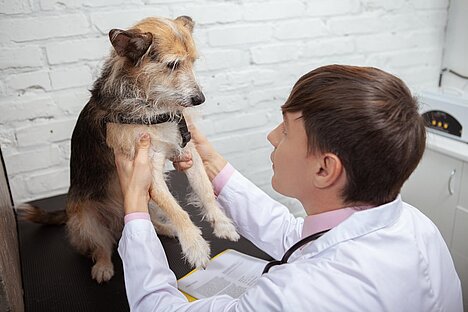Skin rash

Skin rash in dogs is a common problem that can have many different causes. In this article, you'll learn what the most common triggers for skin rash in dogs are, how to recognize the symptoms and what you can do to help your dog.
What is skin rash in dogs?
Skin rash in dogs is an inflammation of the skin that can manifest itself as redness, swelling, itching, scaling or hair loss. The affected areas may feel warm or painful. Skin rash can occur in a specific area or all over the body.
What are the most common causes of skin rash in dogs?
There are many possible causes of skin rash in dogs, ranging from harmless to serious. Some of the most common are:
- Allergies: Dogs can be allergic to various substances, such as pollen, grass, mites, flea or tick bites, food ingredients or medications. Allergies can occur seasonally or all year round and lead to skin rashes.
- Parasites: Parasites such as fleas, ticks, mites or worms can infect and irritate dogs' skin. They can also transmit other diseases that can lead to skin rashes.
- Fungal infections: Fungi such as yeasts or ringworms can infect the skin of dogs and lead to skin rashes. Fungal infections can often be recognized by circular or scaly lesions.
- Bacterial infections: Bacteria such as staphylococci or streptococci can infect the skin of dogs and lead to skin rashes. Bacterial infections can often be recognized by purulent or oozing wounds.
- Autoimmune diseases: Autoimmune diseases are conditions in which the dog's immune system mistakenly attacks its own cells. This can lead to various symptoms, including skin rashes.
- Hormonal disorders: Hormonal imbalances such as hypothyroidism or Cushing's syndrome can affect the dog's metabolism and lead to skin problems.
- Stress : Stress can weaken the dog's immune system and make it more susceptible to skin problems. Stress can be triggered by various factors, such as changes in the environment, separation anxiety or boredom.
How can you recognize skin rash in your dog?
Skin rashes in dogs can look different depending on the cause. Some signs you should look out for are
- Redness or discoloration of the skin
- Swelling or elevation of the skin
- Itching or scratching
- Scaling or hair loss
- Sores, crusts or bleeding
- Unpleasant odor
- Behavioral changes such as restlessness, lethargy or loss of appetite
If you notice one or more of these signs in your dog, you should take him to the vet to determine the cause and receive appropriate treatment.
How can you help your dog with skin rash?
The treatment of skin rash in dogs depends on the underlying cause. The vet may perform various tests to make the diagnosis, such as blood tests, skin scrapings, culture tests or biopsies. Treatment may include the following, depending on the case:
- Antihistamines or steroids to relieve itching and inflammation
- Antibiotics or antifungals to fight infection
- Parasiticides to eliminate parasites
- Immunomodulators or immunosuppressants to treat autoimmune diseases
- Hormone therapy to correct hormonal imbalances
- Allergen avoidance or desensitization to treat allergies
- Stress management or behavioral therapy to reduce stress
In addition to medical treatment, you can also help your dog with a rash by doing the following:
- Keeping your dog's skin clean and dry to prevent infection
- Bathing your dog with a mild, hypoallergenic shampoo to remove dirt and irritants
- Brush your dog's coat regularly to remove dandruff and hair
- Cut your dog's nails short to avoid injuries from scratching
- Use a collar or bodysuit to prevent your dog from licking or biting the affected areas
- Feed your dog a balanced, high-quality diet to promote their skin health
- Provide your dog with plenty of water, exercise and play to improve their well-being
Skin rash in dogs is a common problem that can have many different causes. If you notice signs of rash in your dog, you should take him to the vet to determine the cause and get appropriate treatment. You can also help your dog with a rash by keeping their skin clean and well-groomed, optimizing their diet and stress levels, and giving them lots of love and care.
The authors assume that a veterinarian should be consulted if an animal is ill and that medication should only be taken after consultation with a doctor or pharmacist. Only an individual examination can lead to a diagnosis and treatment decision.
We help you find the nearest vet → This way